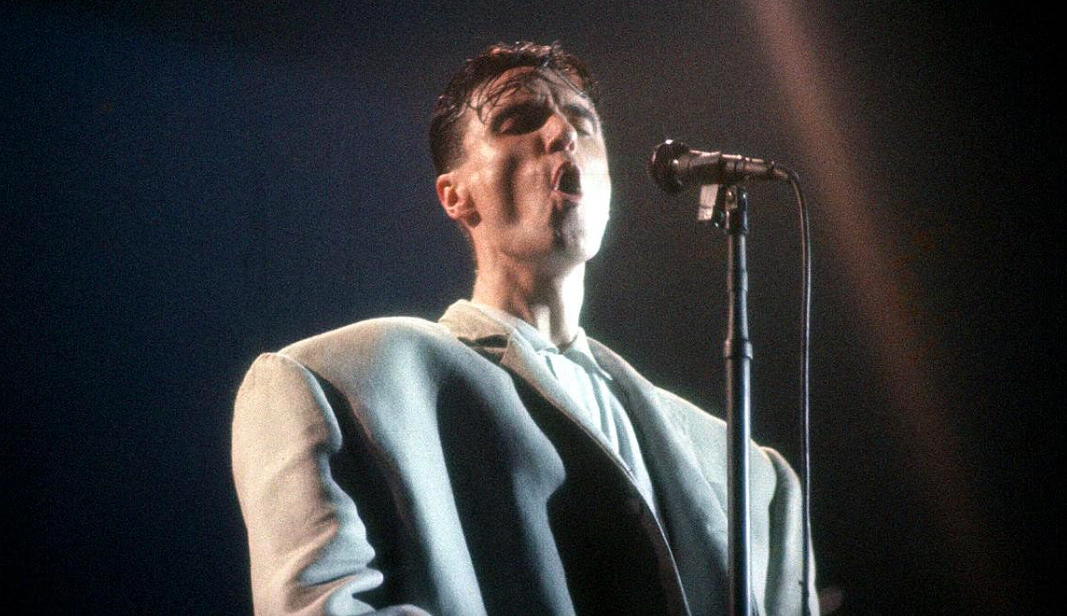On Sept. 29, A24 studios debuted their theatrical re-release of the Talking Head’s iconic concert film, “Stop Making Sense,” in honor of the film’s 40th anniversary. Earlier this year, A24 surprised Talking Heads fans with a promotional trailer featuring frontman David Byrne picking up his iconic oversized suit from the laundry mat. Since then, fans have been patiently awaiting the return of this cult-classic to theaters.
Directed by Academy Award winner Jonathan Demme, “Stop Making Sense” originally debuted in theaters in 1984. The film was shot in front of a live audience over the course of four nights at the Hollywood Pantages Theatre during December 1983. These performances were a part of their 1983 tour promoting their fifth studio album, “Speaking in Tongues.”
Bursting onto the scene in the 1970s, the Talking Heads quickly garnered attention for their unique and unconventional sound. The band was formed in 1975, at the height of the New York punk scene. The line-up includes members David Byrne, the lead vocalist and guitarist, Tina Weymoth on bass, Chris Franz on drums and Jerry Harrison on keyboard and guitar.
They were known for pushing creative boundaries and testing the limits of what music can do. The band was one of the major pioneers of the new wave genre, which emerged during the late 1970s, known for combining elements of pop music with punk influences. The Talking Heads explored genres ranging from art-pop, dance rock and worldbeat. Their funky bass lines, groovy drumbeats and pop-driven lighthearted synth melodies blend seamlessly to accentuate Byrne’s unique vocals that range from delicate whispers to loud, commanding shouts.
The film begins with a shot of Byrnes’ feet. The camera follows his footsteps as he walks out onto an empty stage. Approaching the microphone stand, he sets down a boom box, and addresses the audience: “Hi, I got a tape I want to play.” A steady drum beat comes from the machine, and Byrne begins tapping his feet. The camera pans up to his face, revealing his nervous demeanor, as he makes stark, jittery movements, bobbing his head back and forth to the beat.
He dives straight into a performance of the film’s first song, “Psycho Killer.” Byrne stares off into space as if in a trance, imitating the psychotic behavior of a crazed killer. He sings “I’m tense and nervous/can’t relax,” among a slew of other unsettling claims that play into his nervous, jittery caricature of a psychotic killer. Towards the end of the song, the track skips, emulating the sound of gunfire, as Byrne staggers around stage as if he has just been shot.
With each successive song, a new member of the band appears alongside Byrne, and the crew brings out more sound equipment until there is a complete line-up and the stage is fully set up. The concert line-up consists of the four original band members, along with back-up singers Lynn Marby and Ednah Holt, and additional musicians such as Alex Weir, Steve Scales and Bernie Worrell. The whole ensemble is coordinated in neutral-colored uniforms, which is juxtaposed against the colorful imagery displayed behind the stage.
First, Byrne is joined by Weymoth on bass in the song “Heaven,” followed by Chris Franz on drums on “Thank You For Sending Me An Angel.” Jerry Harrison joins on guitar for “Found A Job.” In the succeeding songs, performance equipment is rolled out onto the stage by crew members, and the rest of the members come out one by one, until the whole performance line-up is present for their energetic performance of “Burning Down The House.”
The energy on stage is contagious. Every member wears a smile on their face as they move freely around stage, dancing and jumping. Byrne’s solo vocals are accompanied by the enthusiastic chants from the whole ensemble as they shout “My house!” “That’s right!” and “Burning down the house!”
In their next song, “This Must Be the Place (Naive Melody),” the band slows things down, letting the lyrics speak for themselves. The members remain stationary throughout the performance, as Byrne delivers his beautiful testament of love. He compares his love to the comfort of home, “Home is where I want to be / Pick me up and turn me round.”
Composed of mostly stand-alone phrases, this song does not have a traditional narrative. However, Byrne’s effortless interweaving of locational imagery in combination with confessions of intimate, personal love create a beautiful unique love song. During the instrumental outro of the song, Byrne ricochets across the stage, grabbing hold of a stand-up lamp, and uses it as a dance partner to accentuate his dynamic, zealous dance moves.
The band ramps their energy back up, as they continue onto their next hit “Once in a Lifetime.” In a half-spoken, half-sung style, Byrne delivers lines from the verses as if he were giving a sermon. “And you may find yourself in a beautiful house, with a beautiful wife / And you may ask yourself, ‘Well, how did I get here?’” In the chorus, the repetition of lyrics “letting the days go by” and “same as it ever was” seem to comment on the everyday life’s monotony.
Taking a brief break from the Talking Heads, the next song, “Genius of Love” is performed by the Tom Tom Club, a side project of band members and couple Weymoth and Frantz. Byrne steps out of the spotlight on this one and gives his bandmates a chance to shine in this funky disco tune.
Returning to the Talking Heads, the band performs “Girlfriend is Better,” in which Byrne can be seen dancing wildly across the stage in his iconic oversized suit, followed by their lively rendition of “Take Me to the River,” in which Byrne makes a point to formally introduce his bandmates. Concluding with “Crosseyed and Painless,” the recording shows cut-scenes of the audience all dancing, and the band says goodnight.
The Talking Heads have continued to captivate audiences for over 40 years. The energy in the film is contagious, as audiences in theaters have gotten up from their seats to dance along to their favorite songs. “Stop Making Sense” captures the Talking Heads in all their weird and wonderful glory, showcasing the band’s zany and spirited performances. The Talking Heads continue to inspire audiences to embrace their creativity and uniqueness, reminding us that in a world of the ordinary, it is ok to stop making sense.
Victoria Thompson can be reached at [email protected].




















